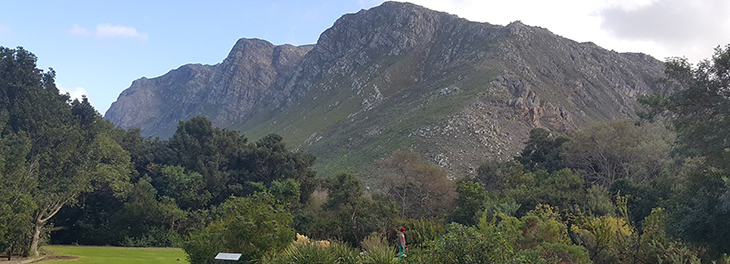Research Features
Botanical gardens are sanctuaries for people who live in cities and enjoy natural surroundings. Yet there is more to botanical gardens than just beautiful scenery. They house vast collections of exotic and native plant species that are important for conservation and research. These plants also have a varied level of susceptibility to pests and pathogens, and therefore can serve as sentinel plants for monitoring emerging plant health problems. It is for this reason that the South African National Biodiversity Institute (SANBI) has funded a postdoctoral research project dedicated to monitoring plant health in botanical gardens and arboreta across South Africa. Two postdoctoral Fellows at the University of Pretoria’s Forestry and Agricultural Biotechnology Institute have held these fellowships, namely Dr Trudy Paap from 2016 until 2018 and Dr Mesfin Gossa from 2019 until the end of 2020.
The aim of the project is to improve surveillance and identify new and emerging pest and pathogen risks using botanical gardens and arboreta in South Africa as sentinel sites. These are high-risk sites that are inspected regularly to detect and identify plant health issues. This research feeds into initiatives by the International Plant Sentinel Network (IPSN), which coordinates sentinel plant research conducted in botanical gardens worldwide, the importance of which was highlighted in Science.
Dr Paap and Dr Gossa have conducted plant health assessments and capacity building activities in many gardens across the country. The capacity building activities include workshops, seminars, and presentations on a range of topics including emerging pests and pathogens of plants, the importance of sentinel plants, biosecurity practices, pest and disease monitoringand best practices in garden maintenance, nursery management and pruning. Practical sessions on pesticide application, pruning methods and detection and identification of causes of poor plant health were also part of the capacity building activities.More than 300 people including curators, estate managers, garden and city park staff, horticultural students, interns, delegates from various nurseries and Department of Environmental Affairs have attended the capacity building activities. This project has benefited curators, estate managers, horticulturalists, interns and municipality staff.
As the world observes the International Year of Plant Health, the plant health research conducted in botanical gardens and arboreta in South Africa has far-reaching implications for the health of the plants in these gardens as well as plant health globally.
Outputs from this project include:
- The first report of Euwallacea fornicatus (also known as the Polyphagous shot hole borer or PSHB) and its fungal symbiont, Fusarium euwallaceae in KwaZulu-Natal National Botanical Garden in 2017
- The first report of PSHB in the National Zoological Gardens in the City of Tshwane Metropolitan Municipality
- The identification of two cryptic aphid species on Widdringtonia nodiflora and W. wallichi in the Kirstenbosch National Botanical Garden in the Western Cape
- Cycad stem borers on cycads, Aloe snout beetles on aloes, and Cycad Aulacaspis Scale and other scale insects on various plants
- Isolation and identification of different pathogens including Phytophthora, Ganoderma and Armillaria species. This includes Phytophthora amnicola, P. asparagi and P.tropicalis which were reported for the first time in South Africa. A new Ganoderma species, Ganoderma eickeri sp. nov. was found and G. cf. resinaceum was reported in the country for the first time
- Capacity-building initiatives for garden staff in garden management and surveillance as well as the detection and management of pest and pathogen problems.
Papers from this research include:
Hulbert JM, Paap T, Burgess TI, Roets F, Wingfield MJ. (2019) Botanical gardens provide valuable baseline Phytophthora diversity data. Urban Forestry & Urban Greening 46: 126461. 10.1016/j.ufug.2019.126461
Tchotet Tchoumi JM, Coetzee MPA, Rajchenberg M, Roux J. (2019)Taxonomy and species diversity of Ganoderma species in the Garden Route National Park of South Africa inferred from morphology and multilocus phylogenies.Mycologia 111(5): 730-747.10.1080/00275514.2019.1635387
Paap T, de Beer ZW, Migliorini D, Nel W, Wingfield MJ. (2018) The polyphagous shot hole borer (PSHB) and its fungal symbiont Fusarium euwallaceae: a new invasion in South Africa. Australasian Plant Pathology 47(2): 231-237. 10.1007/s13313-018-0545-0PDF
Paap T, Burgess TI, Wingfield MJ. (2017) Urban trees: bridge-heads for forest pest invasions and sentinels for early detection. Biological Invasions 19(12): 3515-3526. 10.1007/s10530-017-1595-xPDF
Book chapters:
Potgieter LJ, Douwes E, Gaertner M, Measey J, Paap T, Richardson DM. 2020. Biological Invasions in South Africa’s Urban Ecosystems: Patterns, Processes, Impacts, and Management. In: Biological Invasions in South Africa. van Wilgen BW, Measey J, Richardson DM, Wilson JR, Zengeya TA. (eds). Springer International Publishing, Cham, pp 275-309.
Views articles:
Paap T. (2020) Trees in South Africa are under attack. Why it’s proving hard to manage. The Conversation http://bit.ly/2twjJ3e
De Beer ZW, Paap T. (2018) The spread of shothole borer beetles in South Africa is proving tough to control. The Conversation https://bit.ly/2Dl46ia


